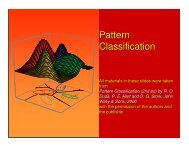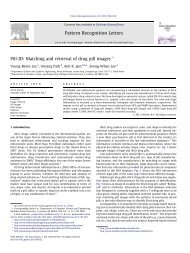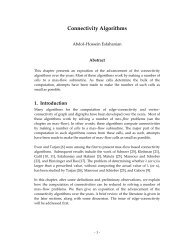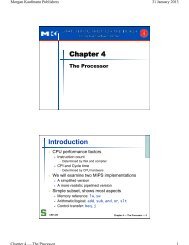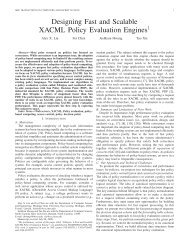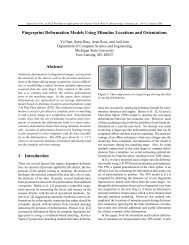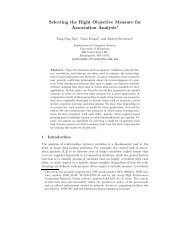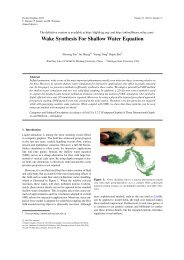Background Subtraction Using Ensembles of Classifiers with an ...
Background Subtraction Using Ensembles of Classifiers with an ...
Background Subtraction Using Ensembles of Classifiers with an ...
You also want an ePaper? Increase the reach of your titles
YUMPU automatically turns print PDFs into web optimized ePapers that Google loves.
efficient classifier when being restricted to low resolution images <strong>of</strong> the objects being tracked,using gradient magnitude as a single feature will <strong>of</strong>fer satisfactory perform<strong>an</strong>ce gains over RGBfeatures.6.2 Future WorkThe optimistic results generated opens the door for m<strong>an</strong>y avenues <strong>of</strong> future research in usingensembles <strong>of</strong> background classifiers.While signific<strong>an</strong>t improvements were shown using Haar features, as well as gradient features,incorporating additional image processing features may allow for a further improvement. Onefeature that would be intuitive to incorporate is texture. Per pixel texture features using Gaborfilters as described in [54], [55] would <strong>of</strong>fer a similar, but distinctly different, representation <strong>of</strong>a pixel th<strong>an</strong> Haar features.Additional features that could be included are the Laplaci<strong>an</strong> <strong>of</strong>Gaussi<strong>an</strong>, non-thresholded SIFT features [56], depth, <strong>an</strong>d motion features.Another direction is the fusion <strong>of</strong> different classifier algorithms. For example, instead <strong>of</strong> usinga series <strong>of</strong> Mixture <strong>of</strong> Gaussi<strong>an</strong> classifiers, <strong>an</strong> ensemble <strong>of</strong> Mixture <strong>of</strong> Gaussi<strong>an</strong>, Kalm<strong>an</strong> Filter,<strong>an</strong>d other classifiers could be used. This approach was the first direction this work researched.The major stopping point was the lack <strong>of</strong> distinct classifiers for background subtraction.Instead<strong>of</strong> fusing strong classifier algorithms, using a series <strong>of</strong> weak algorithms should <strong>of</strong>fer similarimprovements to using <strong>an</strong> extended feature set.An extended feature set could also be used <strong>with</strong>out having multiple classifiers. Because theMixture <strong>of</strong> Gaussi<strong>an</strong>s algorithm normally operates on a feature vector (where the three featuresare RGB), using the same features in this paper as a single vector for one classifier should produceunique results. It may not be the case that signific<strong>an</strong>tly different results are yielded <strong>with</strong> thisapproach unless a full covari<strong>an</strong>ce matrix is computed, which is generally not the case. Insteadit is generally the case that only the diagonal <strong>of</strong> the covari<strong>an</strong>ce matrix is calculated in order toreduce computational dem<strong>an</strong>ds. Another consideration when using a vector <strong>of</strong> features instead<strong>of</strong> <strong>an</strong> ensemble <strong>of</strong> classifiers is that if a single dimension <strong>of</strong> new inst<strong>an</strong>ce vector does not fall<strong>with</strong>in 2.5σ <strong>of</strong> its corresponding dimension, <strong>an</strong>d every other vector dimension does, then theinst<strong>an</strong>ce does not match the distribution. With a larger feature set it is <strong>of</strong>ten the case that notevery feature matches its corresponding dimension for its feature in the model. This approach is55





